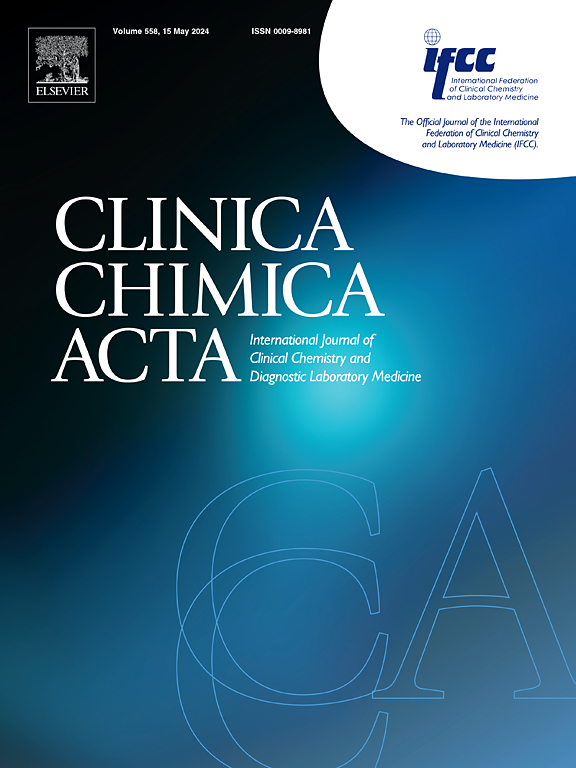Innovative electrochemical biosensors for tuberculosis detection
IF 3.2
3区 医学
Q2 MEDICAL LABORATORY TECHNOLOGY
引用次数: 0
Abstract
Tuberculosis (TB) continues to pose a significant global health threat, highlighting the urgent need for the development of rapid, precise, and accessible diagnostic tools to effectively manage its transmission. Conventional diagnostic techniques, such as sputum microscopy and culture-based assays, face several drawbacks, including lengthy processing times, limited sensitivity, and the requirement for specialized laboratory facilities. In this landscape, electrochemical biosensors have emerged as promising alternatives, offering improved sensitivity, specificity, and rapid detection capabilities. This review presents a thorough overview of recent advancements in the development and application of innovative electrochemical biosensors for TB detection. It explores the integration of nanomaterials such as graphene, gold nanoparticles, and carbon nanotubes, focusing on their contributions to enhanced sensor performance in terms of signal amplification and biorecognition efficacy. By synthesizing current research and technological developments, this review emphasizes the considerable potential of electrochemical biosensors to transform TB diagnostics, ultimately assisting in better disease management and control strategies worldwide.
用于结核病检测的新型电化学生物传感器
结核病继续对全球健康构成重大威胁,突出表明迫切需要开发快速、精确和可获得的诊断工具,以有效管理其传播。传统的诊断技术,如痰液显微镜和基于培养的测定,面临着一些缺点,包括处理时间长,灵敏度有限,以及对专门实验室设施的要求。在这种情况下,电化学生物传感器已经成为有前途的替代品,提供更高的灵敏度、特异性和快速检测能力。本文综述了近年来新型结核检测电化学生物传感器的发展和应用进展。它探索了纳米材料如石墨烯、金纳米颗粒和碳纳米管的集成,重点关注它们在信号放大和生物识别功效方面对增强传感器性能的贡献。通过综合当前的研究和技术发展,本综述强调了电化学生物传感器在改变结核病诊断方面的巨大潜力,最终有助于改善全球疾病管理和控制战略。
本文章由计算机程序翻译,如有差异,请以英文原文为准。
求助全文
约1分钟内获得全文
求助全文
来源期刊

Clinica Chimica Acta
医学-医学实验技术
CiteScore
10.10
自引率
2.00%
发文量
1268
审稿时长
23 days
期刊介绍:
The Official Journal of the International Federation of Clinical Chemistry and Laboratory Medicine (IFCC)
Clinica Chimica Acta is a high-quality journal which publishes original Research Communications in the field of clinical chemistry and laboratory medicine, defined as the diagnostic application of chemistry, biochemistry, immunochemistry, biochemical aspects of hematology, toxicology, and molecular biology to the study of human disease in body fluids and cells.
The objective of the journal is to publish novel information leading to a better understanding of biological mechanisms of human diseases, their prevention, diagnosis, and patient management. Reports of an applied clinical character are also welcome. Papers concerned with normal metabolic processes or with constituents of normal cells or body fluids, such as reports of experimental or clinical studies in animals, are only considered when they are clearly and directly relevant to human disease. Evaluation of commercial products have a low priority for publication, unless they are novel or represent a technological breakthrough. Studies dealing with effects of drugs and natural products and studies dealing with the redox status in various diseases are not within the journal''s scope. Development and evaluation of novel analytical methodologies where applicable to diagnostic clinical chemistry and laboratory medicine, including point-of-care testing, and topics on laboratory management and informatics will also be considered. Studies focused on emerging diagnostic technologies and (big) data analysis procedures including digitalization, mobile Health, and artificial Intelligence applied to Laboratory Medicine are also of interest.
 求助内容:
求助内容: 应助结果提醒方式:
应助结果提醒方式:


